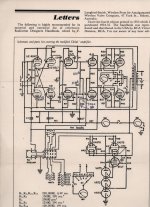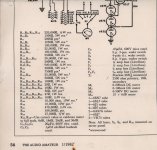Yep, essentially a 6L6 with the anode brought out through the top cap to avoid arcing across pins at high voltages when used in RF applications. The VT-136/1625 is, again, essentially the same, but with a 12.6v filament and a 7-pin base. They saw use in transmitters, pa amps, theater amps, etc. Great tubes in my opinion, tough as nails and still relatively inexpensive.
Use them single-ended or push-pull, either connected in triode or in pentode because of the low max G2 voltage. See just about any 6L6-based schematic for ideas. The Heath W-1, for example, used the 807 connected in triode.
Given the anode cap, they do like to pick up RF. At least in the last amp I built using parallel 1625s (the 12V filament version of the 807) in SE I had to put 10 ohm plate stoppers along with a wire coil wrapped around them to stop the amplifier from oscillating.
They are great, beefy tubes. Lots of WWII era stock still floating around after all these years. The top plate connection is enough to scare away most commercial uses, and the sheer qty created for the war means there won't be a shortage any time soon.
Given the anode cap, they do like to pick up RF. At least in the last amp I built using parallel 1625s (the 12V filament version of the 807) in SE I had to put 10 ohm plate stoppers along with a wire coil wrapped around them to stop the amplifier from oscillating.
They are great, beefy tubes. Lots of WWII era stock still floating around after all these years. The top plate connection is enough to scare away most commercial uses, and the sheer qty created for the war means there won't be a shortage any time soon.
The 807 is an excellent tube, but you would get very little power single ended triode, about 10 to 12 watts single ended Pentode. Don't take any notice of people that claim they cannot handle hi voltage on G2 as triodes; AWA valve company in Australia tested them as triodes and they can easily handle 450 volts; there are commercial amps using them triode at 600 volts. I have built amps triode PP at 550 volts no trouble for many years.
The 807 is a great tube!
Looks great
Sounds great
Good ones available at good prices
Data sheets show a 300V maximum screen rating (i.e. in Beam Power mode).
This problem of screen voltage maximums is not unique to 807 and other Beam Power tubes, it also applies to Pentode tubes (different voltage ratings, but the same principle).
But a 1954 RCA data sheet showed a 400V screen voltage in Triode wired mode.
Screen Current is a function of the control grid voltage (grid voltage goes less negative, screen current goes up).
Screen Current is also a function of whenever the plate voltage falls very far below the screen voltage (plate voltage goes down, screen current goes up).
High screen current can kill the tube.
That is why some data sheets show screen current curves.
But in Triode wired mode, the plate voltage can not fall below the screen voltage, because they are tied together.
In Ultra Linear mode, the plate voltage is already a little lower than the screen voltage, because of the plate current X the DCR from the UL tap to the Plate tap.
Then when signal is applied, the plate voltage falls at a 100% rate, but the screen voltage only falls at a 40% rate; so the plate voltage can fall far below the screen voltage. This happens when the grid is going less negative, so the problem is additive.
This limits the practical screen voltage in UL mode.
Again, this principle applies to Pentode tubes.
Have fun building an 807 amp, and let us know the progress along the way (schematic, parts selection, questions, and eventually the listening).
Looks great
Sounds great
Good ones available at good prices
Data sheets show a 300V maximum screen rating (i.e. in Beam Power mode).
This problem of screen voltage maximums is not unique to 807 and other Beam Power tubes, it also applies to Pentode tubes (different voltage ratings, but the same principle).
But a 1954 RCA data sheet showed a 400V screen voltage in Triode wired mode.
Screen Current is a function of the control grid voltage (grid voltage goes less negative, screen current goes up).
Screen Current is also a function of whenever the plate voltage falls very far below the screen voltage (plate voltage goes down, screen current goes up).
High screen current can kill the tube.
That is why some data sheets show screen current curves.
But in Triode wired mode, the plate voltage can not fall below the screen voltage, because they are tied together.
In Ultra Linear mode, the plate voltage is already a little lower than the screen voltage, because of the plate current X the DCR from the UL tap to the Plate tap.
Then when signal is applied, the plate voltage falls at a 100% rate, but the screen voltage only falls at a 40% rate; so the plate voltage can fall far below the screen voltage. This happens when the grid is going less negative, so the problem is additive.
This limits the practical screen voltage in UL mode.
Again, this principle applies to Pentode tubes.
Have fun building an 807 amp, and let us know the progress along the way (schematic, parts selection, questions, and eventually the listening).
As I recall, Radiotronics put on life tests that ratified the increased 807 screen voltage for triode connection to 400V in the late 1940's due to increasing use in the Williamson amp.
I have done several PP-UL amplifiers with soviet made G807 and used 450 V as +Ub.
I have seen no problems, and some amplifiers have been in regular use since 2010.
I have seen no problems, and some amplifiers have been in regular use since 2010.
The 807 is probably OK at that voltage in UL.
But I would not want to do that for a guitar amp where the player drove it into continuous clipping for a long time. You would end up with screen currents that are a high percentage of the plate currents.
But I would not want to do that for a guitar amp where the player drove it into continuous clipping for a long time. You would end up with screen currents that are a high percentage of the plate currents.
Same here, triode connected PP, B+ is 425VI have done several PP-UL amplifiers with soviet made G807 and used 450 V as +Ub.
I have seen no problems, and some amplifiers have been in regular use since 2010.
But I would not want to do that for a guitar amp where the player drove it into continuous clipping for a long time. You would end up with screen currents that are a high percentage of the plate currents.
That is very likely. Also the higher the load impedance, the lower g2 current.
I have used 6k6, not lower.
The higher the output transformer impedance, the closer to zero volts the plate can go for a given current.
It is typical design practice to get a specified power output: for the B+ voltage to be higher when an output transformer of higher impedance is selected. So for UL, the difference between the plate voltage and screen voltage is greater.
For a doubling of output impedance, and a specified current, the plate swing is double.
For a 40% screen tap, the voltage only moves 40% as far as the plate, but is also doubled because of the doubling of the transformer impedance (but still 40% of the plate swing).
But for a 40% screen tap, the screen winding impedance is 0.4 x 0.4 = 0.16; 16% of the plate winding impedance. The screen has to drive this lower impedance, and the screen current can still be large. The factor that can save the screen is that the plate current times the plate tap impedance aids the screen tap voltage.
Some think that in UL, the screen current adds a significant power to the amp output,
but at 0.16% of the plate impedance, that is only true where the screen current becomes larger than the plate current (like a wildly clipping guitar amp). "Poor Screen, has to really work hard".
It is typical design practice to get a specified power output: for the B+ voltage to be higher when an output transformer of higher impedance is selected. So for UL, the difference between the plate voltage and screen voltage is greater.
For a doubling of output impedance, and a specified current, the plate swing is double.
For a 40% screen tap, the voltage only moves 40% as far as the plate, but is also doubled because of the doubling of the transformer impedance (but still 40% of the plate swing).
But for a 40% screen tap, the screen winding impedance is 0.4 x 0.4 = 0.16; 16% of the plate winding impedance. The screen has to drive this lower impedance, and the screen current can still be large. The factor that can save the screen is that the plate current times the plate tap impedance aids the screen tap voltage.
Some think that in UL, the screen current adds a significant power to the amp output,
but at 0.16% of the plate impedance, that is only true where the screen current becomes larger than the plate current (like a wildly clipping guitar amp). "Poor Screen, has to really work hard".
The G807 are ok but the RCA are better sounding.
Someone else can hear completely the opposite.
The G807 are ok but the RCA are better sounding. I did an A-B comparison.
🙄
807 triode amp 50 watt
A 50 watt Triode amplifier
Childs amplifier with voltage regulator. There are versions with out the regulator and using 6SN7 not 6J5. I think with solid state rectifiers you don't need the regulator, takes up a lot of room, or use a solid state regulator.
you could use mosfets instead of the 6sn7 Cathode follower
A 50 watt Triode amplifier
Childs amplifier with voltage regulator. There are versions with out the regulator and using 6SN7 not 6J5. I think with solid state rectifiers you don't need the regulator, takes up a lot of room, or use a solid state regulator.
you could use mosfets instead of the 6sn7 Cathode follower
Attachments
- Status
- Not open for further replies.
- Home
- Amplifiers
- Tubes / Valves
- 807/VT-136 amp circuits

